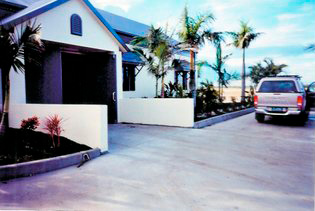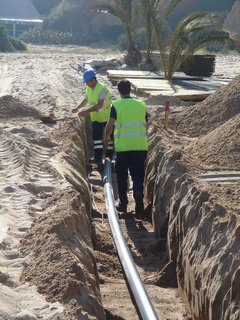How Vacuum Sewerage Systems Work
Please have a look through our interactive typical system to see different aspects of the system. naturally every system is different, but all systems will have a pump station, valves and pipework.
Interactive PDF vacuum system layout
This is an interactive PDF and shows how a typical vacuum system is laid out, describing key components and some additional ways in which vacuum sewers are used. To navigate through the diagram, click on a label to view a brief description.
The Interactive PDF shows the different components and applications for a vacuum sewer system. The Vacuum Pump Station (6) has four vacuum mains (3) covering the whole development. Approximately 2,600 houses will ultimately be serviced by the Flovac system and will be staged over a number of years. On average 4 houses are connected to a Collection Pit (4) which houses the Flovac Valve (5). This system services houses as well as commercial areas, a Hospital (7), office buildings (8), a golf course resort and club house as well as a marina (10) which includes a suck out point for the boats.
The system includes a valve monitoring system (11) that allows the owners to detect if infiltration is occurring or if there are any problems within the system. This has reduced operational costs, as all callouts can be prioritised, energy savings are made and labour costs are lower as the time in the field is shortened.
How do vacuum sewerage system work?
Vacuum sewerage systems are used in a variety of situations including, Marina’s; Green Buildings; Hospital’s; Industrial area’s; Army, Emergency and Mining Camps; and the principals of operation are the same as in residential areas where a vacuum system may have replaced an old septic tank or gravity system or in a new housing development.
It is a sewerage system which uses differential air pressure and gravity to rapidly transport sewage in a network of essentially empty pipes from Collection Pits to a central collection tank and then to a point of discharge.
A batch of sewage enters the vacuum system when the atmospheric Flovac Valve opens in a Collection Pit and the sewage is sucked into the Vacuum main. The Flovac Valve remains open briefly following the removal of the sewage from the pit sump allowing atmospheric air to enter the suction pipe and blow the sewage batch toward the Vacuum Pump Station.
Unlike the older vacuum sewerage systems the transport in modern systems is fast and notably not due to a syphon.
Is a vacuum sewerage system the right choice for your project?
The Vacuum Pump Station (VPS) houses a collection tank (to collect the sewage); discharge pumps to send the sewage to the treatment plant; controls to automate the station and vacuum pumps which create a negative pressure in the vacuum mains. (-0.5 -0.7 bar). Usually only one VPS is required in an average sized catchment.
Ideally a Vacuum Pump Station is located centrally within a catchment area, but the designer can be flexible about this. A backup generator can be located at the VPS ensuring non stop operation in areas where power is a problem or susceptible to Hurricanes or Cyclones.
The Collection Pit houses the 90mm (3 inch) Flovac Vacuum Valve which interfaces between the atmosphere coming from the gravity lines and the negative pressure in the vacuum mains created by the vacuum pumps at the VPS. The VPS may be as far as 5km (3 miles) away from the last collection pit.
Once 40 litres (10 gallons) enters the pit from the gravity line, air pressure on the valves controller will trigger the valve to open allowing sewage and then air to enter the vacuum mains at a velocity of 4-6 metres per second (15-18 feet per second).
It is the expanding air that propels the sewage to the VPS (the point of stronger negative pressure).
No power is required at the collection pit.
The Vacuum Mains (either PE or PVC) are designed to be as shallow in the ground as possible and are laid at a 1/500 grade. The contractor builds steps in the pipework to keep the mains from getting too deep. The more steps that are installed, the more hydraulic losses are created, lessening the distance that the mains can go.
It is important to have collection pits evenly distributed around the catchments and along the vacuum mains to ensure fast movement of sewage to the VPS.
SMART monitoring of the system (either wireless or cable) can inform the operator or any problems within the network. This can identify infiltration or illegal stormwater connections from the homeowner, the energy efficiency of the system through its use of air, and any blockages or failures that may occur. Flovac System Monitoring pdf download
For more information please Contact Us.
FLOVAC
Flovac is the world’s leading vacuum sewerage engineering, supplier and operation company.
Primer de Maig 4 Street
08980, Barcelona
Spain

CONTACT US
COPYRIGHT © 2021 FLOVAC - THE GREEN FUTURE OF SEWERAGE





